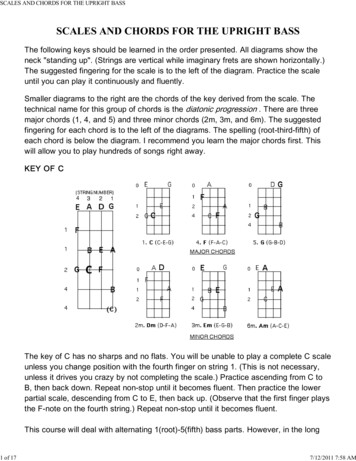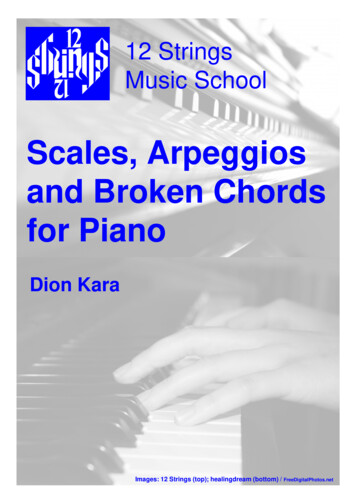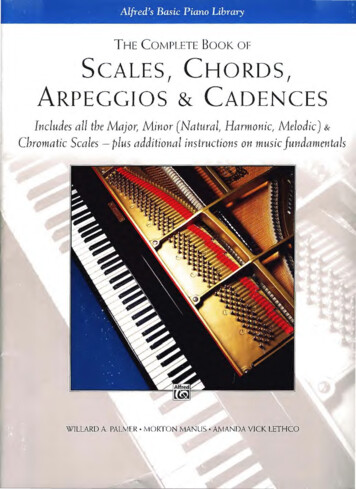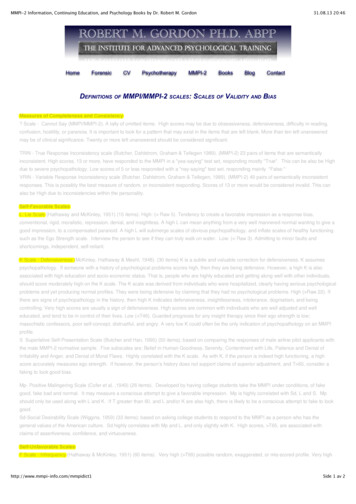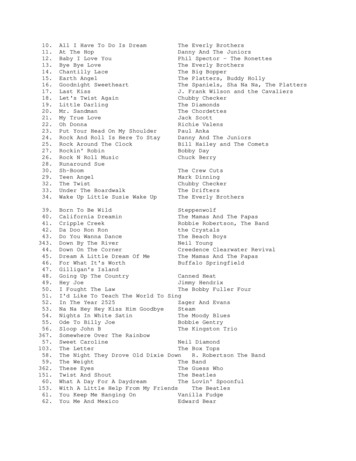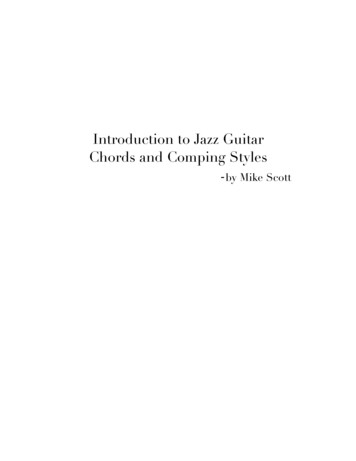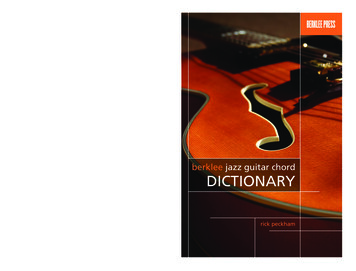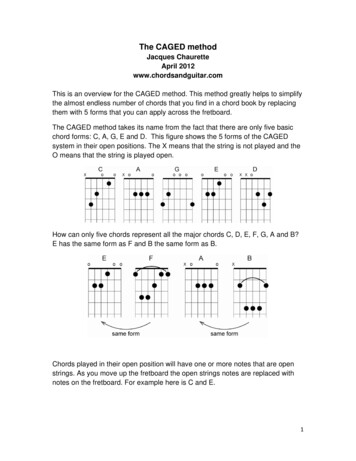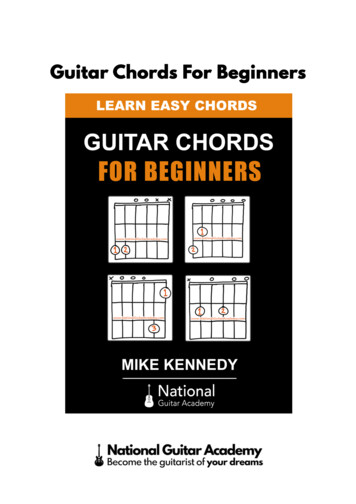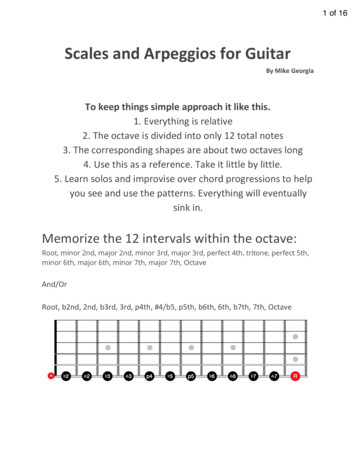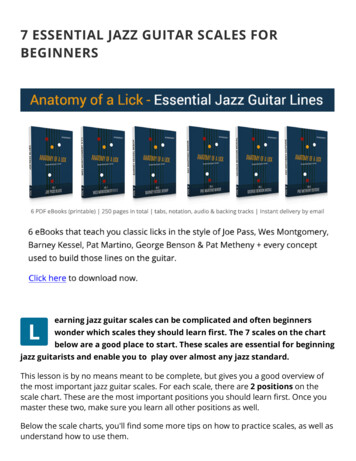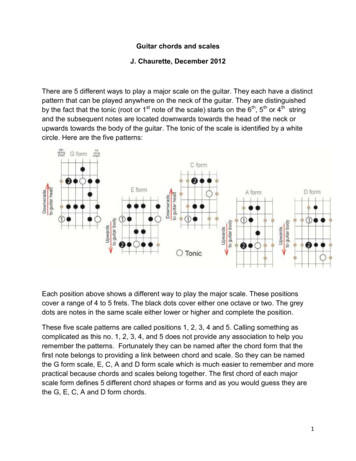
Transcription
Guitar chords and scalesJ. Chaurette, December 2012There are 5 different ways to play a major scale on the guitar. They each have a distinctpattern that can be played anywhere on the neck of the guitar. They are distinguishedby the fact that the tonic (root or 1st note of the scale) starts on the 6th, 5th or 4th stringand the subsequent notes are located downwards towards the head of the neck orupwards towards the body of the guitar. The tonic of the scale is identified by a whitecircle. Here are the five patterns:Each position above shows a different way to play the major scale. These positionscover a range of 4 to 5 frets. The black dots cover either one octave or two. The greydots are notes in the same scale either lower or higher and complete the position.These five scale patterns are called positions 1, 2, 3, 4 and 5. Calling something ascomplicated as this no. 1, 2, 3, 4, and 5 does not provide any association to help youremember the patterns. Fortunately they can be named after the chord form that thefirst note belongs to providing a link between chord and scale. So they can be namedthe G form scale, E, C, A and D form scale which is much easier to remember and morepractical because chords and scales belong together. The first chord of each majorscale form defines 5 different chord shapes or forms and as you would guess they arethe G, E, C, A and D form chords.1
The notes circled in yellow show the open chord forms.Why D form and not just D chord, because this D shape can be played up and down theneck, there is only one place on the neck that it can be called a D chord.One way to practice the 5 different scale forms is to play the tonic first instead of startingon the 6th or top string. This way your ear will help you play an octave correctly and youcan add the low or high notes easily to cover a 4 or 5 wide fret zone.How does this help you be a better musician? It gives you more options; it allows you toplay the same notes or chords on a different part of the neck which will be 1 or 2octaves up or down. It opens up all the notes of the guitar to you. Nice eh?The following chart provides all the 3-note chords that correspond to the notes of the Fmajor scale. The notes of the chords are chosen by starting on a note then skipping thenext note, keeping the third note, then skipping the next note and keeping the fifth note.For example, the F chord of the F major scale has the notes F, A and C, so we skippedthe A and B notes.2
The most important characteristic of chords is whether they are major or minor. Thechords of a major scale are made of major and minor chords. All songs in the Westernworld are played in a major scale or a variant of it. Our ear can be easily trained todetect a major chord and a minor chord. This is very helpful if you want to learn a songby ear instead of having to go out and buy the partition.3
You are probably wondering why there are X’s on the 6th string of the C and A formchord and on the 6 and 5th string of the D form chord. The X indicates that the note isnot to be played. In the case of the C form chord (open form) you could play the note onthe 3rd fret which is a G since the G is also a not in the chord. However, a C chordshould always start with a C, if it doesn’t it is known as an inversion and depending onwhich note is played first it will be the 1st or second inversion. The first inversion isindicated with an uppercase 6 or C6 and the second inversion as uppercase 6 andlowercase 4 or C64. The first inversion is also known as C/E or C slash E indicating thatthe E is played first. Many songs have chords with a first or second inversion, it can behard to detect and looking for that chord maybe difficult if an inversion is not suspected.In the case of the A form open chord the 6th string cannot be played at all because it isnot a part of the chord. The chord should start on the open 5th string which is the A.In the case of the D form open chord the 6th and 5th strings are normally not played andyou start on the open 4th string which is a D. However you could start on the 6th stringwhich is an F# and that is the first inversion D6 or D/F# and you can also start on the 5thstring which is an A forming the 2nd inversion or D64 or D/A.The distinction between major and minor depends on the interval between the first twonotes of the chord, if the interval is a major third which is 4 fret-steps (or frets) on theguitar it is a major chord, and if it is a minor chord it is 3 fret-steps. A fret-step is oftencalled a semi-tone or a half-step. I find this terminology confusing and if you are playingthe guitar every fret moves you up or down by a semi-tone so why not call them fretsteps. The interval between the 1st and 3rd note is a perfect fifth or 7 fret-steps and isthe same for a major or minor chord.Because the notes of the major scale are separated by different intervals, when youform a chord by starting on any note and skipping every subsequent note you get apattern of chords, major, minor, minor, major, major, minor and diminished, and thisapplies to any major scale. For example the C major scale will have the chords C, Dm,Em. F, G. Am and Bdim.So once you figure the key of the song which is not that difficult because it is often thefirst or last chord played then when you hear the other chords of the song most of themwill likely belong to the scale of that key and they will be familiar to you.4
5
There are also many minor scales that are derived from the major scale.And the chords that are derived from these scales are shown in the following figures.6
7
8
pattern that can be played anywhere on the neck of the guitar. They are distinguished by the fact that the tonic (root or 1 st note of the scale) starts on the 6 th, 5 th or 4 th string and the subsequent notes are located downwards towards the head of the neck or upwards towards the body of the guitar. The tonic of the scale is identified by a white
